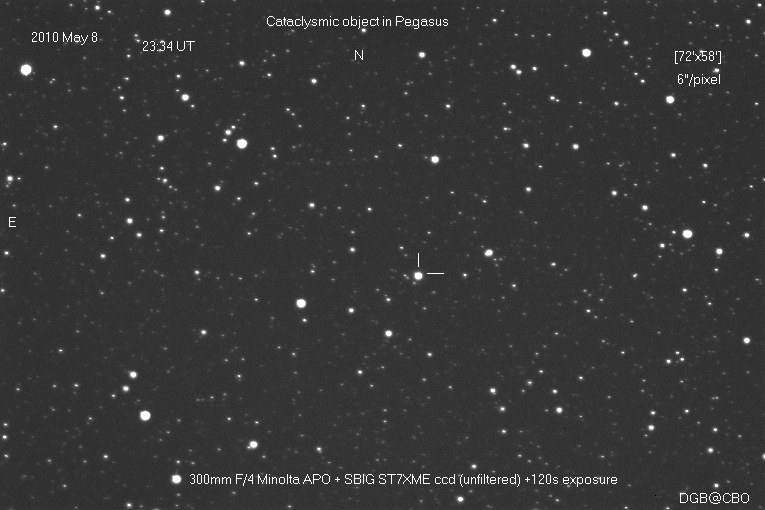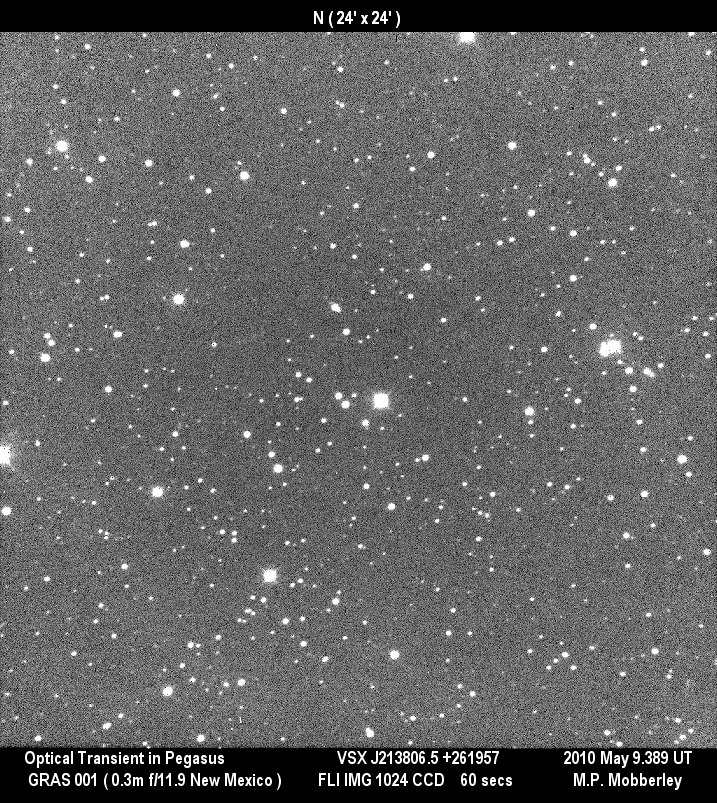
Subject: AAVSO Special Notice #208: Optical transient in Pegasus
AAVSO Special Notice #208
Optical transient in Pegasus
May 8, 2010
CBET 2273 (D.W.E. Green, editor) reports the discovery of a bright
transient in Pegasus by Dae-Am Yi (Yeongwol-kun, Gangwon-do, Korea).
The object was discovered at magnitude 10.8 on 2010 May 6.77 (JD
2455323.27) on an image taken with a Canon 5D + 93-mm camera lens. The
object brightened to magnitude 8.4 as observed on 2010 May 7.76
(2455324.26) on an image taken with a 400-mm lens. The transient object
appears to be concident with GSC 2197:886 on discovery images, but this
identification is not yet proven. The GSC star has a NOMAD catalog V
magnitude of 13.84 and is a close double with a separation of about 3
arcseconds. Based upon an examination of the POSS-I and POSS-II plates
by Arne Henden, it is possible that the double is composed of two
unassociated stars, one with a high proper motion. Observations of this
field are strongly encouraged both to obtain astrometry of the source
and to follow the progress of this outburst. It was noted by H. Yamaoka
(Kyushu University) that there is a bright ROSAT X-ray source within
seven arcseconds of the GSC star, and so the object may be a cataclysmic
variable of some kind.
CBET 2273 gives the coordinates of the GSC star for the object, which are
RA: 21 38 06.571 , Dec: +26 19 57.33
Charts for this object may be plotted using AAVSO VSP:
http://www.aavso.
5%2B261957
Please promptly submit all observations to the AAVSO using the name
"VSX J213806.5+261957"
This AAVSO Special Notice was prepared by M. Templeton.
From Prof. Boris Gaensicke on vsnet-alert 11979...
"the optical transient in Pegasus, recently reported in
CBET 2273 and CBET 2275 (currently designated
VSX J213806.5+261957 or
OT_J213806.6+261957) has been detected in the GALEX All-Sky Survey in quiescence
(MJD=53955.8) at m(fuv)=16.15+-0.03, F(fuv)=1257.58 +/- 33.16 microJy and m(NUV)=16.15+-0.02,
F(nuv)=1260.16 +/- 23.79 microJy. The behaviour of this transient resembles an
outburst of a WZ Sge star. The ultraviolet spectrum of WZ Sge stars is dominated
by emission from the white dwarf photosphere. The flat ultraviolet spectrum of
OT_J213806.6+261957 observed by GALEX is compatible with a white dwarf
temperature of ~15000K, similar to that of WZ Sge itself. Assuming a 0.6Msun
white dwarf mass, the GALEX fluxes imply a distance of ~70pc. Such a short
distance is consistent with the proper motion of the object discussed by Henden
in CBET 2275. It appears now most likely that OT_J213806.6+261957 is indeed a WZ
Sge star, i.e. a short-period cataclysmic variable with a low accretion rate and
rare but large-amplitude outbursts, and it might be among the closest known
members of this class.

Dennis Buczynski

Martin Mobberley